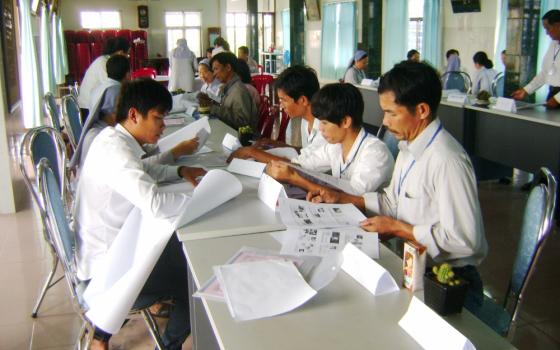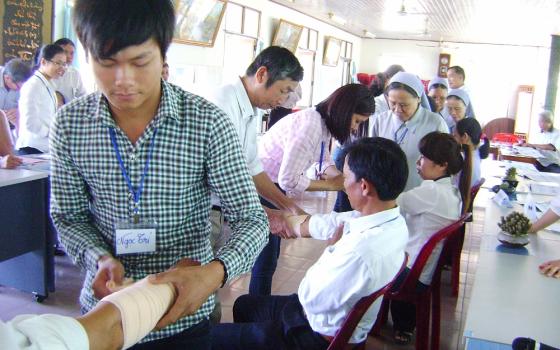After helping farmers last summer to develop climate-resilient livelihood options in central Vietnam’s Thua Thien Hue province, an area that is particularly vulnerable to effects of extreme weather, local nuns have taken another major step in providing health care to people who have fallen victim to diseases flourishing in new weather conditions.
Nuns from the Daughters of Our Lady of Immaculate Conception held a three-day course in November about diseases caused by climate change. Thirty-five volunteers, including eight nuns, working in 10 parishes based in mountainous and coastal regions came to the sisters’ Charity Clinic of Kim Long in Hue City for the clinic.
Participants studied the effects of extreme weather, the impacts of climate change on human health and the prevention of accidents and health problems relating to respiration, skin, eyes and digestion caused by drought and flood. They also learned how to give first aid to injured people and victims of lightning strikes, near-drowning and sunstroke.
Three trainers from the Catholic Group for Climate Change Prevention (CGCCP), whose members are nuns and laymen, taught the participants.
Trainers had finished a national-level training course on prevention of diseases caused by climate change last November from the Community Capacity Development (CYCAD), a local non-governmental organization.
The course was sponsored by CYCAD and Norwegian Church Aid (NCA), an ecumenical diaconal organization that is focused on ensuring public access to fundamental health care and supporting vulnerable communities so that they are better able to face climate change.
“Our main aim is to train participants as first care givers serving climate change victims. They will form rescue teams at their parishes,” Sr. Anna Nguyen Thi Hien, head of the clinic, said.
Sr. Hien said regrettably some victims of lightning and drowning have died untimely deaths because they were not given proper first aid before reaching the hospital.
Participant Matthew Le Van Ngoc said local people suffer from sunstroke and fall unconscious from working 10-hour days in the fields when temperatures can reach 104 degrees F (40 degrees C). Some people die from this because they are not hospitalized in time.
He said in rainy seasons, farmers suffer from waterborne diseases like diarrhea and petechial fever.
Some participants at the training said that due to widespread deforestation, more poisonous snakes have been coming to their fields and gardens looking for food. Tens of people have been bitten by snakes, and some have died.
The provincial Committee for Flood and Storm Prevention recorded in 2013-2014 the province that is prone to annual flooding has seen drought destroy 32,000 acres (13,000 hectares) of rice. There have been regular sea water flows into people’s fields as the sea erodes 32 to 98 feet of coastline per year for a span of nearly three miles, affecting local 1,000 households. The first earthquake measuring 4.7 on the Richter scale was reported last May.
Participants said they found the course useful and necessary and that they would use what they learned to save lives and protect vulnerable people’s health.
Sr. Hien said three rescue teams based at parishes of Duong Son, Kim Doi and Ngoc Ho have served local people well during recent annual flooding last fall.
Bartholomew Le Van Ngoc, a voluntary rescue worker from Kim Doi parish, said rescue teams rowed boats to homes near rivers and in low lands and took people to the parish church. Victims were treated, offered drinking water, instant noodles, rice and blankets while they stayed until the flood water receded.
Sr. Hien said CGCCP plans to raise funds to equip rescue teams at parishes with canoes, life vests, flashlights and other things. The group will also educate parishioners on disaster risk reduction.
[Joachim Pham is a Global Sisters Report correspondent based in Vietnam.]


